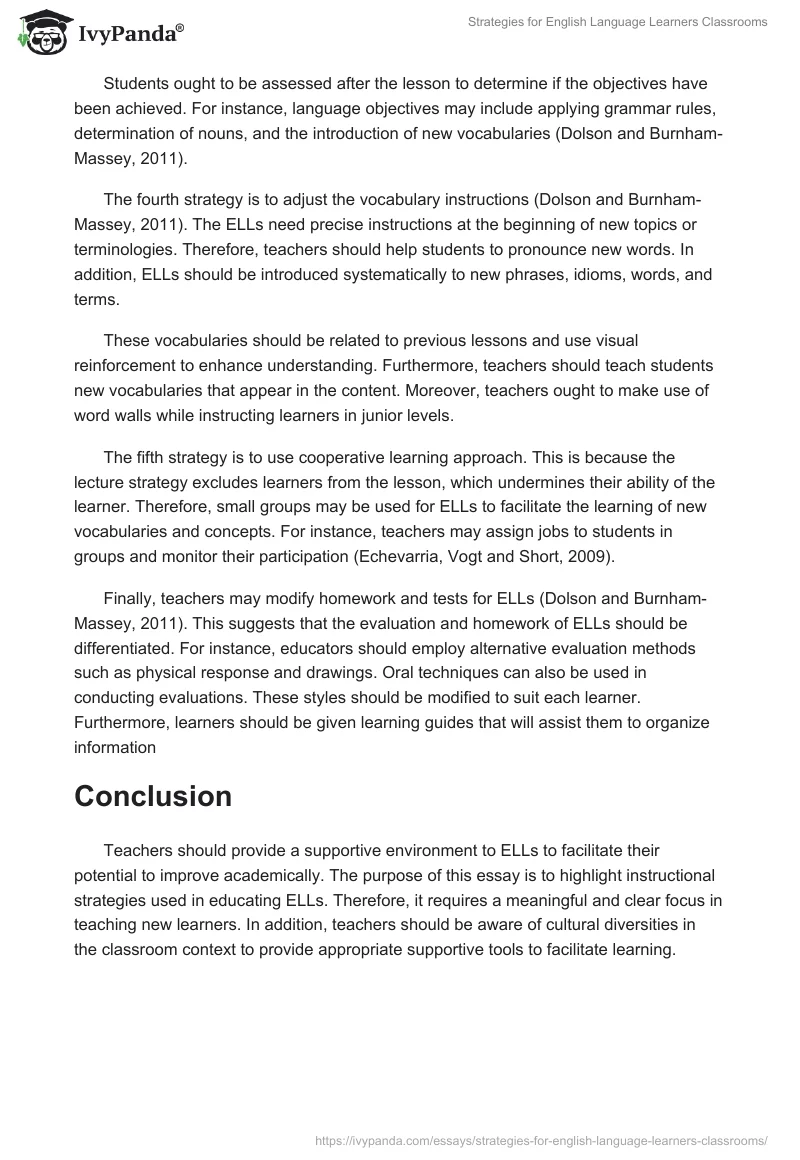Introduction
In both rural and urban settings, teachers are responsible for facilitating English Language Learners (ELLs) (Echevarria, Vogt, and Short, 2009). A study conducted by the California Department of Education (2010) notes that the approach used to educate ELLs determines the students’ outcomes. These strategies seek to help learners to be self-efficacious. Based on these findings, this essay discusses instructional strategies in Ell’s classrooms.
Strategies
First and foremost, Dahlman, Hoffman, and Brauhn (n.d.) note that teachers should make the lecture visual. This means that teachers can use visual representations when introducing new vocabularies and concepts. This may include charts, drawings, photographs, maps, and graphs. Also, teachers may illustrate new vocabularies using stories. For instance, they may use story maps and diagrams in their lessons California Department of Education, 2010).
Secondly, the teacher should link new information to the previous knowledge acquired (Echevarria, Vogt and Short, 2009). Therefore, they should take into account plans used by the ELLs in the learning environment. They should relate their teaching content to the learners’ cultural and personal experiences. This means that the teacher should understand how culture affects learning in the classroom. This will help them to adjust their strategies to reflect the cultural diversity in the class.
Thirdly, teachers should identify significant concepts in the content, define the language, and outline the content objectives to guide each lesson. These key concepts should be written in a student-friendly language. They can also start each lesson by outlining their objectives on the board.
Students ought to be assessed after the lesson to determine if the objectives have been achieved. For instance, language objectives may include applying grammar rules, determination of nouns, and the introduction of new vocabularies (Dolson and Burnham-Massey, 2011).
The fourth strategy is to adjust the vocabulary instructions (Dolson and Burnham-Massey, 2011). The ELLs need precise instructions at the beginning of new topics or terminologies. Therefore, teachers should help students to pronounce new words. In addition, ELLs should be introduced systematically to new phrases, idioms, words, and terms.
These vocabularies should be related to previous lessons and use visual reinforcement to enhance understanding. Furthermore, teachers should teach students new vocabularies that appear in the content. Moreover, teachers ought to make use of word walls while instructing learners in junior levels.
The fifth strategy is to use cooperative learning approach. This is because the lecture strategy excludes learners from the lesson, which undermines their ability of the learner. Therefore, small groups may be used for ELLs to facilitate the learning of new vocabularies and concepts. For instance, teachers may assign jobs to students in groups and monitor their participation (Echevarria, Vogt and Short, 2009).
Finally, teachers may modify homework and tests for ELLs (Dolson and Burnham-Massey, 2011). This suggests that the evaluation and homework of ELLs should be differentiated. For instance, educators should employ alternative evaluation methods such as physical response and drawings. Oral techniques can also be used in conducting evaluations. These styles should be modified to suit each learner. Furthermore, learners should be given learning guides that will assist them to organize information
Conclusion
Teachers should provide a supportive environment to ELLs to facilitate their potential to improve academically. The purpose of this essay is to highlight instructional strategies used in educating ELLs. Therefore, it requires a meaningful and clear focus in teaching new learners. In addition, teachers should be aware of cultural diversities in the classroom context to provide appropriate supportive tools to facilitate learning.
References
California Department of Education. (2010). Improving education for English learners: Research-based approaches. Sacramento, CA: California Department of Education.
Dahlman, A., Hoffman P. & Brauhn, S. (n.d.). Classroom Strategies and Tools for Differentiating Instruction in the ESL Classroom. Web.
Dolson, D. P. & Burnham-Massey, L. (2011). Redesigning English-medium classrooms: Using research to enhance English learner achievement. Covina, CA: California Association for Bilingual Education.
Echevarria, J., Vogt, M., & Short, D. J. (2009). Making content comprehensible for elementary English learners: The SIOP model. New York: Allyn & Bacon.


